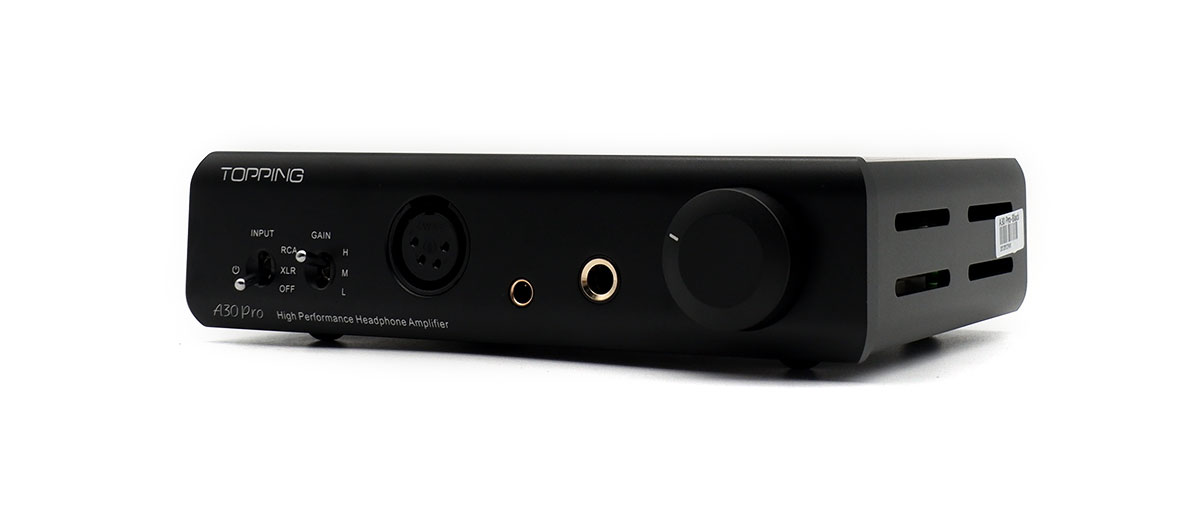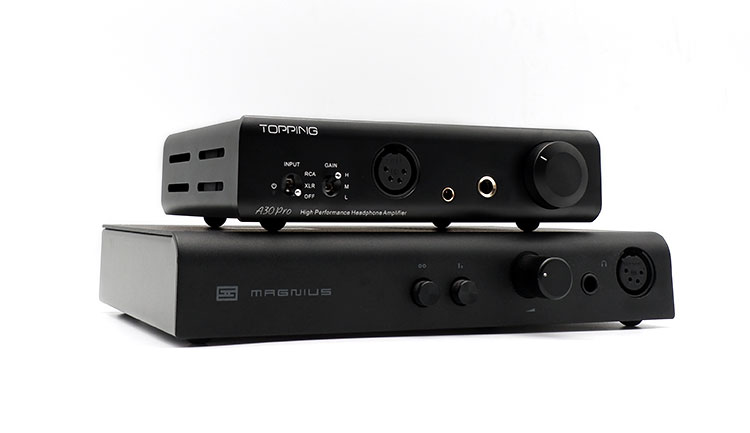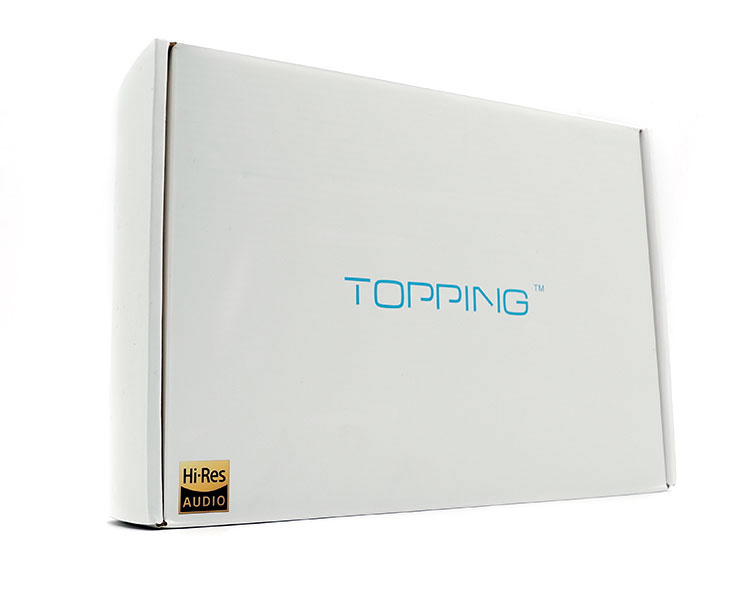Select Comparisons
Topping L30
Design
Being the little brother of the A30 Pro, the L30 is a much smaller device. However, the L30’s transformer is housed inside an external power brick which adds quite a bit of weight to the entire system. While the A30 Pro is a much larger device, it uses a standard IEC power cable, instead of the large wall wart that comes with the L30.
The layout of the front fascia of the 2 devices immediately makes the family resemblance very evident. The L30 has 2 3-way toggle switches on the far left. The first one serves as the power/mode switch, where the L30 can be run either as a headphone amplifier or a pre-amp. The 2nd switch is the same as the one found on the A30 Pro which allows for switching between the 3 gain modes.
In the middle of both devices are their respective headphone outputs. However, the L30 only has a ¼” headphone output, while the A30 Pro has 3 different output options for convenience.
The rear of the L30 is quite a bit simpler than the A30 Pro’s since the L30 is strictly limited to single-ended operation both at the input and the output side. So the L30 only has RCA inputs and a pair of RCA outputs.
However, the L30’s RCA outputs are pre-amp outputs, while the A30 Pro is just a passthrough RCA, so in a way, the L30 has a leg up over the A30 Pro in this regard.
Technical
The most notable difference between the 2 devices on the specs sheet is the power output capability of the 2 devices. The 16Ω output of the L30 tops out at 3.5W, while the A30 Pro is rated at 6W, which is almost double the power output.
However, as the impedance ratings are going up, the A30 Pro has a distinct advantage, where the power output becomes more than double at 5.5W @ 32Ωcompared to the L30’s 2.3W. The 300Ω power rating is even higher on the A30 Pro at 840mW against the L30’s 280mW.
Power ratings aside, the A30 Pro and the L30 are built on the same NFCA topology. This allows both devices to have a very linear sound signature while having a diminishingly low THD of just 0.00007%.
However, the THD numbers won’t tell the whole story, the A30 Pro boasts a better dynamic range and crosstalk measurements at 145dB and 106dB respectively, compared to the L30’s 141dB dynamic range, and -91dB crosstalk.
Performance
On paper, the 2 devices utilize the same topology and they end up having similar measurements as well. So it would be easy to summarily assume that the A30 Pro and L30 would sound the same right? Well not really.
On the surface level, they actually sound quite similar. Where both amplifiers are very linear throughout the frequency spectrum. They are both also quite punchy in the bass while having a touch of euphony in the midrange. The treble is detailed while staying away from being too bright. But most importantly, they are both very transparent to the source.
However, the similarities end with the general tonality and timbre of both amplifiers. The layers within the soundstage are a bit more spaced out on the A30 Pro, giving it a more open feeling. Images are also clearer and more chiseled with the A30 Pro, giving a better sense of directionality within the soundscape.
Textures are also a touch more fleshed out with the A30 Pro, in contrast to the more glossed presentation on the L30. The biggest difference between the L30 and the A30 Pro is when they are playing more complicated passages that play both a bass line, a vocal track and a cymbal crash.
This gives the L30 a bit of a hard time, where it trips over its own feet a bit, while the A30 Pro confidently sails through these more complicated passages.
SMSL SH-9
Design
The chassis of both amplifiers are made of aluminum which also dissipates heat that is generated by the amplifiers. The A30 Pro just has many holes on top and on the sides of the device to dissipate more heat.
Where the SH-9 has a more modern aesthetic, primarily relying on a 1.9” TFT screen in conjunction with the volume knob or the included remote control. In contrast, the A30 Pro is a more analog implementation, which primarily relies on knobs and switches for the controls of the device.
While digital may seem to be more modern, both devices can keep a consistent channel balance throughout the volume range. This is done through the use of the switched resistor volume control on the SH-9, while the A30 Pro uses 3 gain stages to maintain precision.
I ended up preferring the more analog implementation of the A30 Pro though because volume adjustments are a bit quicker than having a resistor switched volume control.
The available headphone outputs are similar, where they both have a 4-pin XLR and ¼” output, but the A30 Pro has a 4.4mm pentaconn connection. Both have those connections for convenience though, so buying a 4.4mm pentaconn adaptor for the SH-9 will allow for connection to headphones terminated in 4.4mm.
The rear of both devices is similar, where there are inputs for RCA and a pair of 3-pin XLRs. However, the A30 Pro has a pair of pass-through outputs, for both RCA and a pair of balanced ¼” outputs. Also notable is that the A30 Pro has a ground/lift switch at the rear, while the SH-9 doesn’t have an option for eliminating ground loops.
Technical
The goal of both the A30 Pro and the SH-9 is to create a generally linear sound signature. But each company achieved the same goal by going through a different route. Topping achieves this through their own NFCA topology, while SMSL does it via employing THX-based chips to achieve a linear sound signature.
Both the A30 Pro and the SH-9 have just 1 set of power output numbers, so it’s easy to assume that both amplifiers’ balanced ports are just there for convenience. This isn’t a knock on the sound quality of either amplifier though.
The output numbers start very similarly where both amplifiers output at 6W into 16Ω. However, the rated power output drops down significantly more quickly with the SH-9, where the output for 32Ω drops to 3W against the 5.5W available with the A30 Pro, then it further drops down to 220mW into 600Ω compared to the A30 Pro’s 420mW.
These numbers show that the A30 Pro is designed to deliver a bit more power at higher impedances.
Performance
Both amplifiers achieve a deep low end, reaching down deep into the sub-bass region. Going into the mid-bass region, both of them have about the same mid-bass quantity.
However, the presentation of the mid-bass is a touch colder on the SH-9, especially in contrast to the punchier, and more hefty drum hits that the A30 Pro produces.
The vocal range on both amplifiers has a generally natural presentation. Where the SH-9 presents vocals and other acoustic instruments with a bit more liquidity, and richer harmonic balance. While the A30 Pro has a comparatively dry presentation, while still having a pinch of harmonic richness that gives vocals that more euphonic flavor.
Treble is about equally emphasized on both amps, where neither amp tends towards being too bright. To achieve this result, the 2 amps implemented slightly different solutions. Where the SH-9 has a more glossed-over treble response, while the A30 Pro is more controlled and naturally reined in.
Soundstage is quite contrasting on the 2 amplifiers though, where the SH-9 has a more walled-in soundstage in comparison to the A30 Pro’s more expansive soundstage presentation. The layer separation is also a bit more spaced out with the A30 Pro. The image directionality is about equally accurate on both amps, however, the images sound a touch more chiseled with the A30 Pro.
The emphasis on the dynamic range advertised by Topping with the A30 Pro leaves a strikingly different presentation of classical tracks. The A30 Pro plays more naturally and more powerfully at appropriate moments within the track. This is not to say that the SH-9 only plays at a single volume, however, there is just a touch more control and contrast with the A30 Pro.
Schiit Magnius
Design
The Magnius is much larger than the A30 Pro, but the 2 devices weigh about the same. Probably because the A30 Pro has a thicker aluminum chassis, compared to the thin metal chassis on the Magnius. The aluminum chassis on the A30 Pro is not purely for aesthetics though, since it can double as a heat sink for the 10 op-amps inside the device.
Both devices are riddled with vent holes on top of the device, but the vent holes on the Magnius are primarily used to show the power LED, while the A30 Pro’s holes are for heat dissipation.
The Magnius’ front fascia only has an input selection button and a gain button. These buttons are slightly more confusing in real-life use though since it’s a bit hard for me to memorize what a depressed button means, compared to the toggle switches on the A30 Pro that point to the state of the A30 Pro at that point in time.
Also glaringly absent in front of the Magnius is a power switch, which is stubbornly located at the rear of the device.
The rear of the A30 Pro is also a bit more crowded, but surprisingly, the spacing of the inputs and outputs of both devices are similar. The Magnius’ balanced outputs use a pair of 3-pin balanced XLR, while the A30 Pro uses a pair of balanced ¼” outputs.
One thing to note about the Magnius though is that the outputs on the Magnius serve as pre-amp outs while the A30 Pro only has a pair of passthrough outputs.
Technical
The Magnius is a balanced version of Schiit’s own Magni Heresy amp, that utilizes op-amps to create an amplifier that measures very well. So in a way, the goal of the Magnius and the A30 Pro is quite similar in that they are both designed to become linear and good measuring amplifiers.
The Magnius is a true-balanced amplifier though, so the single-ended output of the Magnius has a much lower rated output power than the balanced outputs.
On the balanced outputs though, the A30 Pro and the Magnius have similar output numbers, where they both offer 6W into 16Ω. As the impedances increase, both amplifiers have a similarly rated power level, with the Magnius having a slightly higher rated power at 500mW into 600Ω compared to the A30 Pro’s 420mW.
It’s worth noting though that the A30 Pro’s power numbers are the same for both balanced and single-ended outputs. That way, it can drive a wider variety of headphones since it won’t be power limited even when it’s being run through its single-ended output.
Performance
What’s immediately apparent when comparing the 2 devices is that the Magnius is markedly the less linear of the two. Tonally, there is a slight treble recession with the Magnius that pushes back the treble quite a bit.
On first listen, I was excited to hear the Magnius’ more energetic low end. Where drum hits have a more impactful and heftier presentation, even compared to the A30 Pro’s lively presentation. It was also immediately apparent that the Magnius has a slightly more euphonic midrange tonality.
These qualities initially drew me to Magnius’ more energetic character. However, the A30 Pro’s more measured approach in the low end and the more subtle euphonic character made for a more natural and coherent presentation. The treble on the A30 Pro is also notably more forward while staying safely away from being harsh.
Aside from having a more linear tonality, the A30 Pro is also a step above the Magnius in terms of detail retrieval. Drum hits come across as more textured, giving a sense of hollowness while having a natural sense of impact.
The midrange tonality on the A30 Pro is more fleshed out, where the vocal textures of powerful vocalists like Josh Groban come across more clearly. Piano tones are also more natural, being able to produce a more sparkly treble, while instrumental timbre comes across more vividly.
The soundstage is quite close between the 2 amplifiers since they are equally expansive. However, once images are being formed within the soundstage, the A30 Pro pulls ahead once again by having a slightly more layered presentation, with the images being a touch more chiseled, compared to the fuzzier images created by the Magnius.
Our Verdict
I was initially disappointed to find out that the A30 Pro’s different outputs are just for convenience, and are just single-ended in reality. However, this turned out to be a blessing in disguise, since this ensures that the amplifier runs optimally through either of the 3 output options.
The A30 Pro is built around Topping’s NFCA topology, giving it that distinctive linear presentation while having an overall enjoyable experience while listening. Despite lacking some of the modern conveniences of its competitors, the A30 Pro can easily compete against them with its overall more refined but still enjoyable presentation.
Topping A30 Pro Specifications
- Power: 100-240VAC 50Hz/60Hz
- Power Output 6W @ 16Ω
- 5W @ 32Ω
- 840mW @ 300Ω
- 420mW @ 600Ω
- Gain -14/0/14 dB
- Amplifier inputs 1 xXLR (L+R) / 1 xRCA (L+R)
- Headphone Amplifier outputs 1 X 6.35mm headphone output jack
- 1 X XLR headphone output jack
- 1 X 4.4mm headphone output jack,
- Pass through outputs 35mm TRS(L+R)/1xRCA (L+R)
- Power consumption <9.0W
- Dimension 4cmx13.8cmx4.5cm
- Weight 870g





